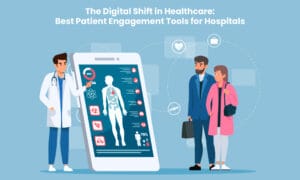
In today’s digital era, the healthcare industry has embraced technological advancements to enhance patient care and streamline operations. However, this digital transformation has also made healthcare institutions vulnerable to cyber threats. Hospitals, doctors, and clinics handle sensitive patient data, making it critical to prevent data leaks and unauthorised access to patient records. Cybersecurity in healthcare is not just about protecting data but also about ensuring patient safety and trust.
The Critical Importance of Cybersecurity in Healthcare
The healthcare industry is a prime target for cybercriminals due to the vast amounts of valuable data it holds. Electronic Health Records (EHRs) contain a wealth of personal information, including medical history, insurance details, and financial data, making them highly lucrative on the dark web.
The risks of cyber threats extend beyond financial losses, impacting patient safety and trust. A successful ransomware attack can paralyse hospital operations, delaying critical treatments and potentially putting lives at risk. The research work “Cybersecurity In Healthcare” published by Ponemon Institution clearly states that 89% of healthcare organizations experienced data breaches in the past two years.

Risks of Cyber Threats in Healthcare
• Ransomware: Holding Patient Care Hostage
Ransomware attacks pose a significant threat by encrypting critical hospital systems, including Electronic Health Records (EHRs) and essential medical devices. Cybercriminals then demand a ransom for the decryption key, effectively holding patient care hostage.
The resulting downtime disrupts vital operations, delays critical treatments, and can ultimately endanger patient lives. This type of attack exploits the urgent need for continuous medical services, making hospitals particularly vulnerable. To know more about the ransomware attacks, refer the blog titled “Cybersecurity in Healthcare: The Methods & Importance of Medical Data Protection”.
• Data Breaches: Exposing Sensitive Patient Information
Data breaches occur when unauthorised individuals gain access to patient records, exposing sensitive Protected Health Information (PHI). This can lead to severe consequences, including identity theft, financial fraud such as insurance scams, and significant reputational damage to the healthcare provider.
Furthermore, data breaches often trigger costly legal and regulatory penalties, adding to the financial burden on healthcare organizations. As per IBM’s 2023 Cost Of Data Breach Report, healthcare data breaches cost an average of $10.10 million per incident.
• Phishing and Social Engineering: Exploiting Human Vulnerability
Cybercriminals employ phishing and social engineering tactics to deceive healthcare staff. These attacks involve deceptive emails, messages, or phone calls designed to trick employees into revealing login credentials, sensitive data, or clicking on malicious links. By exploiting human error, these tactics bypass technical security measures, making them a persistent and effective threat.
• Insider Threats: Risks From Within the Organization
Insider threats arise from employees, contractors, or other authorised individuals who intentionally or accidentally compromise data security. Malicious insiders may steal data for personal gain, while negligent insiders can expose data through careless actions. Detecting insider threats is particularly challenging, as these individuals already possess authorised access to sensitive information.
• IoT Device Vulnerabilities: Expanding the Attack Surface
The increasing use of Internet of Things (IoT) devices in healthcare, such as connected medical devices like pacemakers, insulin pumps, and monitoring systems, introduces new security vulnerabilities.
These devices can be exploited to gain unauthorised access to patient data or manipulate device functions. Often, these devices are overlooked during security updates, leaving them vulnerable to cyberattacks. According to HIPAA Journal’s 2023 Cybersecurity Report, around 700 healthcare data breaches were reported in the U.S. in 2023.
Real-Life Incidents and Current Cybersecurity Issues
• The Universal Health Services (UHS) Ransomware Attack (2023): UHS, a major hospital chain in the U.S., faced a significant ransomware attack that disrupted services and led to patient data exposure.
• Singapore’s SingHealth Data Breach (2022): Personal information of 1.5 million patients, including the Prime Minister, was compromised.
• Los Angeles Medical Center Cyberattack (2023): Hackers accessed patient records and demanded ransom for data release.
Benefits of Robust Security Measures
Implementing robust cybersecurity measures offers numerous benefits:
• Enhanced Patient Trust: Demonstrating a commitment to data security builds trust with patients, fostering stronger relationships.
• Improved Operational Efficiency: Secure systems minimise downtime and disruptions, ensuring smooth operations.
• Regulatory Compliance: Adhering to regulations like HIPAA helps avoid costly penalties and legal issues.
• Protection of Intellectual Property: Safeguarding research data and proprietary information is crucial for innovation.
• Reduced Financial Losses: Preventing cyberattacks can save significant costs associated with data breaches and recovery.
Best Practices for Protecting Patient Data
Implement Strong Access Controls: Use multi-factor authentication (MFA) and role-based access control (RBAC) to restrict access to sensitive patient information.
• Regular Security Audits and Risk Assessments: Conduct frequent audits to identify vulnerabilities and mitigate risks before cyber threats exploit them.
• Data Encryption: Encrypt patient data both in transit and at rest to prevent unauthorised access and data breaches.
• Employee Training and Awareness: Educate healthcare staff on identifying phishing attempts and social engineering tactics to avoid falling victim to cybercriminals.
• Backup and Disaster Recovery Plans: Implement robust backup solutions and disaster recovery plans to ensure quick data restoration in case of cyber incidents.
• Secure Network Infrastructure: Deploy firewalls, intrusion detection systems, and endpoint protection to safeguard the network from external attacks.

Partnering with Reliable Healthcare IT Solutions Providers
By partnering with experienced healthcare IT solution providers that offer optimum healthcare solutions, hospitals can access the expertise and resources needed to implement robust security measures. In addition, they offer tailored healthcare IT solutions that address the specific needs of healthcare organizations.
Conclusion
Cybersecurity in healthcare is vital for protecting patient data and ensuring the smooth operation of healthcare facilities. With the rising threats of ransomware, data breaches, and cyberattacks on medical devices, healthcare IT solutions must incorporate robust security measures.
Healthcare solution providers must adopt best practices, including encryption, access control, and regular security audits, to safeguard patient data. By prioritising cybersecurity, healthcare organizations can achieve optimum healthcare delivery while maintaining patient trust and compliance with regulatory standards.





